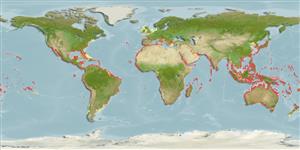Phaeophyceae |
Ectocarpales |
Chordariaceae
Environment: milieu / climate zone / εύρος βάθους / distribution range
Οικολογία
; εύρος βάθους 0 - 26 m (Αναφ. 102128). Tropical
Atlantic Ocean: from Texas, USA to Saõ Paulo, Brazil, including Gulf of Mexico, Bermuda and the Caribbean, east to the Mediterranean Sea and south to Angola, including Azores, Madeira, Salvage, Canary and Cape Verde Island; Indian Ocean: from the Arabian Sea, including Persian Gulf and the Red Sea, south to South Africa including Aldabra Islands, Seychelles, Madagascar, Rodrigues Island and Réunion, east to Sri Lanka; in the Bay of Bengal from Bangladesh to South Australia, including Laccadive Islands, Maldives, Andaman Islands, Nicobar Islands and Diego Garcia Atoll; Pacific Ocean: from Japan to the South China Sea south to New Zealand, including Tasmania, Federated States of Micronesia, Marshall Islands, Fiji and Lord Howe Island, east to California, USA, including French Polynesia, Hawaiian Islands, Samoan Archipelago; south in Mexico and Chile, including Easter Island. Tropical to subtropical.
Length at first maturity / Μέγεθος / Weight / Age
Γεννητική Ωρίμανση: Lm ? range ? - ? cm
Thalli light brown or yellowish brown, characteristically net-like due to numerous perforations
which range from 0.5 to 12.0mmin diameter; in between the holes, the fleshy strands have enrolled margins and vary from 0.5 to 2.5 mm in thickness. Thalli form extensive mats (Ref. 80758).
Used for human consumption: mixed with other vegetables in salads; contains iodine, mannitol, protein, vitamins, folic and folinic acids; also used for animal feed and fertilizer; has growth regulator substances similar to auxin, gibberellin, and cytokinin; contains alginic acid. A highly seasonal species, abundant only during the summer months. In protected coves, abundant during spring and summer months (Ref. 80758). A highly seasonal species, abundant only during the summer months. A dominant component of the intertidal seaweed community; an abundant species during spring and summer months in protected coves, reef flats and bays at the lower littoral zone near the low tide mark. Either attached to rocky substrate, often associated with Colpomenia sinuosa, or forming thick piles on sandy bottom, or floating (Ref. 80758).
Life cycle and mating behavior
Γεννητική Ωρίμανση | Αναπαραγωγή | Γεννοβολία | Eggs | Γονιμότητα | Larvae
Guiry, M.D. and G.M. Guiry 2009 AlgaeBase. World-wide electronic publication, National University of Ireland, Galway. http://www.algaebase.org; searched on 14 April 2009. (Αναφ. 80701)
IUCN Red List Status
(Αναφ. 130435: Version 2025-1)
CITES status (Αναφ. 108899)
Not Evaluated
Not Evaluated
Threat to humans
Human uses
αλιεία: Εμπορικό(ά)
| FishSource |
Εργαλεία
Περισσότερες πληροφορίες
Τροφική ΟικολογίαFood items (preys)
Σύσταση δίαιτας
Κατανάλωση τροφής
Θηρευτές
Population dynamicsΑύξησηMax. ages / sizesLength-weight rel.Length-length rel.Length-frequenciesMass conversionΑφθονία Life cycleΑναπαραγωγή
Γεννητική Ωρίμανση
Γονιμότητα
Γεννοβολία
Eggs
Egg development
Larvae
PhysiologyΚατανάλωση οξυγόνου
Human RelatedStamps, coins, misc.
Διαδικτυακές πηγές
Estimates based on models
Preferred temperature
(Ref.
115969): 17.6 - 29.2, mean 27.4 (based on 6834 cells).
